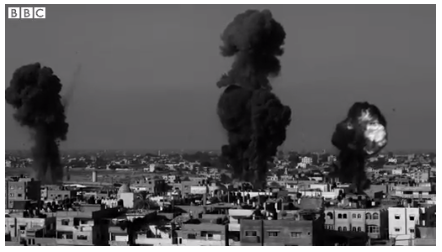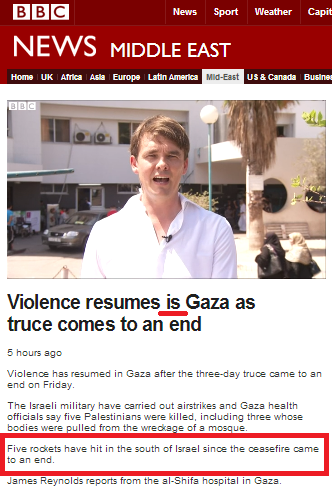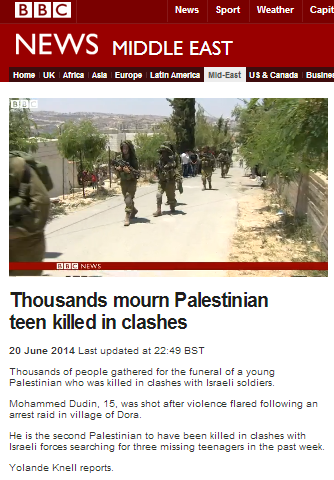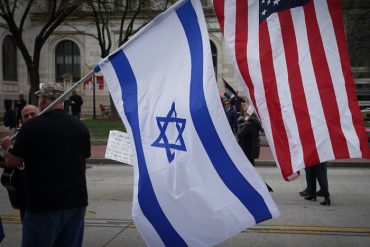On August 3rd 2014 the BBC told its audiences that Israeli forces had attacked a UN school in Rafah.

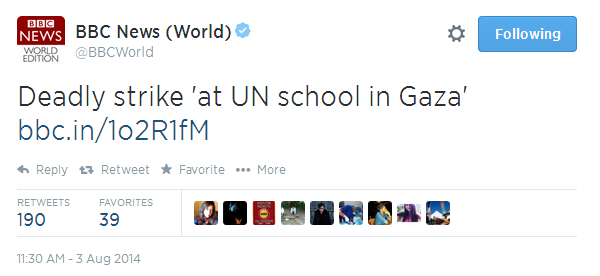
BBC correspondent Martin Patience produced a filmed report titled “Gaza crisis: Chaos after deadly strike ‘at UN school’” in which he informed viewers that Israel was serially attacking UN schools.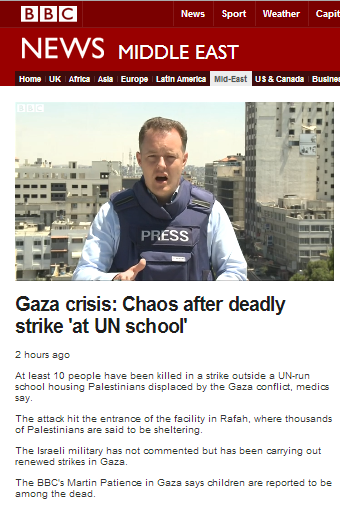
“Eye witnesses say that it was an Israeli airstrike. It struck at the entrance of this UN school in the southern town of Rafah. Now it’s believed children are among the dead. We also understand that at least thirty others have been injured. Ah…now this is the third deadly attack on a United Nations school since this conflict began. Just last week Israel faced international condemnation after an attack on a UN school left at least 17 dead.” [emphasis added]
In an article which appeared on the BBC News website on the same day, quotes from UN officials were given amplification.
“UN Secretary General Ban Ki-moon described the attack as a “moral outrage and a criminal act”.”
“In a strongly worded statement, Mr Ban called for those responsible for the “gross violation of international humanitarian law” to be held accountable.”
“Robert Turner, director of operations for the UN Palestinian refugee agency in Gaza, said: “The locations of all of these installations have been passed to the Israeli military multiple times.
“They know where these shelters are. How this continues to happen, I have no idea.””
An edition of the BBC World Service radio programme ‘Newshour’ broadcast on August 3rd 2014 is also available online. Two years on, listeners can still hear presenter Rebecca Kesby’s inaccurate allegations: [emphasis added]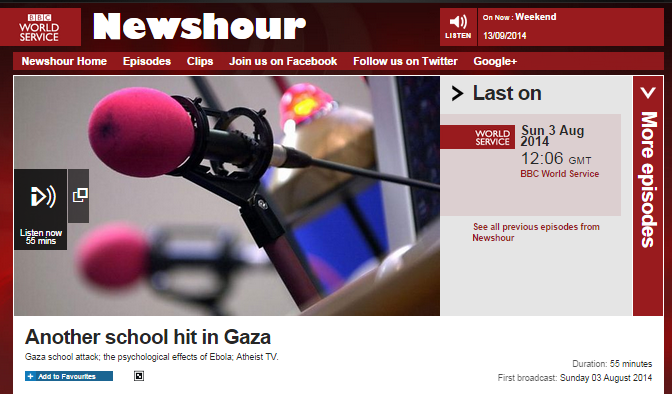
RK: “Well the UN seems pretty convinced that it was an Israeli shell that hit their school. Robert Turner has been saying that it’s now the third such facility of theirs that your forces have hit. He’s very cross. He says that the UN keeps telling the Israeli forces the precise location of all their facilities where people are going to take shelter and they keep being hit.”
RK: “People listening to this will be very cross to hear this again – just three days after another attack on a UN school which provoked widespread condemnation around the world. You talk about surgical strikes and precision bombing but the evidence is very different.”
“On the question of the UN-run school that was hit in Rafah this morning: when will you know if it was your rocket that killed those ten people and injured those 30 others?”
“Excuse me, sir, but you’re telling Palestinians to evacuate from their homes and seek shelter. They seek shelter at UN schools. You then bomb the schools. Whether it’s near the school or not, it’s not safe for them there, is it?”
The Military Attorney General recently published the results of the investigation into that incident (section 7 here). [emphasis added]
“In media reports, as well as in the complaints and reports of NGOs and international organizations, it was alleged, that on August 3, 2014, at around 10:45, a number of civilians were killed and others injured, as the result of an IDF aerial strike in proximity to a Rafah school run by UNRWA. The number of fatalities varies from report to report, and ranges from seven to fifteen fatalities. According to the main allegation arising in the aforementioned complaints and reports, the strike took place a few meters from the gate of the school, which was at that time serving as a shelter for civilians who had evacuated their homes, at the exact moment when the gate was open, and was aimed at a motorbike that was passing through the area and its riders. The incident was subsequently referred to the FFA Mechanism for examination.
The factual findings, collated by the FFA Mechanism and presented to the MAG, indicate that the school was designated as a “sensitive site” on the relevant operational systems of the IDF. In accordance with the IDF’s operational instructions, any military operation to be conducted in the vicinity of such sites requires the adoption of special precautions. The fact that the school was serving at the time as a shelter for civilians who had evacuated from their homes was also noted on the relevant systems.
It was further found, that on 3 August 2014, the IDF observed three people riding on a motorbike, who were identified, on the basis of up-to-date intelligence information, as military operatives. From the moment that the decision to strike the operatives was made, the IDF carried out aerial surveillance on the motorbike’s path, and surveyed a wide radius of the estimated continued route of the motorbike, in order to minimize the potential for harm to civilians on the route or in proximity thereto. The final destination of the military operatives was not known to the operational authorities. The strike on the military operatives was planned for execution by means of a precise munition, with a reduced explosive load, in a way that would allow for the strike’s objective to be achieved, whilst minimizing the potential for harm to civilians or passing vehicles.
It was further found, that a period of time after the munition had been fired, and mere seconds before it reached its target, the motorbike entered a traffic circle with a number of different exits, and left it via one of them. The FFA Mechanism’s findings indicate that with the means that were at their disposal, and under the visibility conditions prevailing at that time, the operational authorities were not able to discern in real-time the group of civilians that were outside the school, in proximity to the route along which the aforementioned motorbike was travelling. It was further found that, in any case, at the moment upon which the motorbike exited the traffic circle and started to travel along the road bordering the wall which surrounded the school, it was no longer possible to divert the munition which had been fired at the motorbike.
The strike on the motorbike riders occurred immediately after the motorbike passed by the gate of the school. As mentioned above, it is alleged that as a result of the strike between seven and fifteen people in the vicinity of the school’s gate were killed (as indicated above, the number of fatalities varies from report to report). According to the findings of the FFA Mechanism, three military operatives were among the fatalities.
After reviewing the factual findings and the material collated by the FFA Mechanism, the MAG found that the targeting process in question accorded with Israeli domestic law and international law requirements.
The decision to strike was taken by the competent authorities, and the object of the attack was lawful – military operatives. The attack complied with the principle of proportionality, as at the time the decision to attack was taken it was considered that the collateral damage expected to arise as a result of the attack would not be excessive in relation to the military advantage anticipated to result from it (essentially, it was considered in real-time that the strike would only harm the military operatives targeted). This assessment was not unreasonable under the circumstances, in light of the fact that aerial surveillance of the routes which the motorbike was predicted to take, which had commenced when the decision to strike was taken, had not shown any civilian presence on those routes.
Moreover, the attack was carried out in conjunction with various precautionary measures, such as the selection of the munition used to carry out the strike, which aimed to mitigate the risk to civilians and passing vehicles. It was also found that under the circumstances, the operational authorities had not foreseen that the strike on the motorbike would take place in the vicinity of the school, and that, in any case, at the time at which it became clear that the strike would occur in proximity to the school, they did not have the capacity to prevent the strike from taking place in that location. The fact that, in practice, civilians who were uninvolved in the hostilities were harmed, is a tragic and regrettable result, but does not affect the legality of the attack ex post facto.”
Obviously footnotes need to be added to the relevant reports still available online in order to clarify to members of the public that the claim that the UN school was attacked is inaccurate.
Likewise, a similar clarification needs to be added to the BBC News website article titled “Gaza conflict: Disputed deadly incidents” which is also still available online and in which audiences are told that:
“Locals have told the BBC there were no militants in or near the school.”
Since the end of the conflict between Israel and terror groups in the Gaza Strip two years ago, investigations into several of the incidents reported by the BBC have shown (see related articles below) that audiences were at the time given inaccurate and misleading information.
To the best of our knowledge, none of the specious reports which still remain available online (and form part of what the BBC terms ‘historical record’) have been amended to inform the general public of the outcome of investigations into the incidents and to correct inaccurate and misleading information included in their content. The failure to take such necessary steps risks the waste of publicly funded resources on complaints relating to those reports due to the fact that the BBC’s editorial guidelines state that if content is still available online, it may legitimately be the subject of editorial complaints.
Related Articles:
BBC’s Martin Patience tells TV audiences that Israel attacks UN schools
BBC claims that Israel targeted a centre for the disabled in Gaza shown to be inaccurate
BBC reports on Wafa hospital shown to be inaccurate
Clarifications required for BBC reports on Shati incident
Revisiting BBC reporting on July 2014 Shuja’iya market incident
BBC News passes up on the chance to correct Gaza misinformation
A BBC story from August 2014 still in need of clarification

